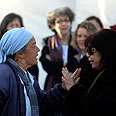
Confrontation at Western Wall
צילום: דודי ועקנין
Esther's sisters at the Wall
Like Esther, Women of the Wall oppressed by violations of human dignity
With spring flurries of almond blossoms wafting about Jerusalem, the new month of Adar will soon breeze in. Observing a 21 year-strong custom, Women of the Wall plan to gather at the Kotel for prayers to celebrate a month whose festival mocks the ruses of power.
What do Queen Esther and Women of the Wall have in common? On Purim, we read in the Scroll of Esther about a king stomping out a women's empowerment movement and how ultimately a woman prevails against a preposterous government edict. Queen Vashti refuses King Ahashuarosh's command to appear at his men's drinking party.
Her defiance arouses fear and anger. The king's demand must be obeyed; a woman, whatever her status, must submit to her role. Simone de Beauvoir writes, “Woman is an object through whom the male subject fulfills himself; her beauty is a measure of him.” By expressing her will, the queen suggests the possibility for every woman to express her will. The King's courtiers foresee that women throughout the empire will follow the queen's example. They claim that the royal court sets the standards for behavior as far as the farthest province; women will begin to scorn and disrespect the power of their male spouses, they argue (Est. 1:16-18).
The biblical text documents the sovereign argument: a woman who exercises autonomy threatens the order of society. A number of assumptions underlie this argument. Firstly, maintaining female subservience is of utmost importance. Secondly, fear and insecurity lurk behind the facade of male dominance.
The rulers adopt a two-pronged policy to redress the concerns raised by the queen's insubordination. First, they dispatch orders to all provinces in all languages asserting that every man “should wield authority in his own home” (Est. 1:22). Second, the court proclaims an “order and edict” appointing officers to collect all beautiful young women to the King's fortress, to his harem (Est. 2:3).
This second action seeks to compensate for the offense to male prowess committed by one woman who refused a man's order to appear. The law reinstates the status quo; it subjects every woman to male scrutiny and selection, forcing women to appear at a man's whim, and even to sleep with him. These laws reveal the coercion used to deny women autonomy and to enforce women's submission. Convinced that women are primed to rebel, Ahashuarosh's court buttresses the fortress of male power.
Oppression of women sets stage for racism
So what is the relevance of this ancient story to Women of the Wall?Both ancient and modern edicts repress women to protect sovereign male prerogatives; state and religious authorities segregate, cover, and silence women, and thwart women's choices. Under guard in Ahashuarosh's harem, women soak in oils, spices, and oppression through their pores, and comply.
In Israel, during the past 21 years, ultra-Orthodox religious groups have tried many methods to constrain women's religious expression at the Western Wall - by intimidation, curses, spitting, violence, tear gas, and attempts to criminalize prayer shawl-wearing and Torah-reading with penalties of up to seven years imprisonment.
Like in Shushan, the administration and court accede. Recently, two women were arrested. The Supreme Court, the Knesset, and the police share the ancient Persian fear of havoc that might arise from women's independence; fear of public disorder is the main argument given for disallowing the prayers of Women of the Wall.
Women donning prayer shawls and reading from the Torah do upset male exclusivity in the Israeli public domain. Resistance to women's visible and active prayer points to the extent of male dominion over public space and resources, and perhaps also to the same fear of challenge that drove Ahashuarosh's court to its repressions.
The Scroll mocks the king and his bawdy court, spoofing the drunken excesses of power. While the extreme enforcement of gender roles is part of the spoof, the Scroll also reveals how Ahashuarosh's oppression of women sets the stage for the racism that ensues. Haman's obsession with Mordecai's disobedience echoes Ahashuarosh's obsession with Vashti's. Both contrive to put down the insolent group, women, then Jews. The King's senseless parties and policies jeopardize life itself.
Esther calls to repeal the edicts of genocide and leave lives intact. But the King's orders cannot be repealed, for they are upheld as if they come from a divine source. Following his sanctimonious policy to its deadly conclusion, the court dispenses with life itself rather than admit the fallibility of the sovereign edict. In the final debacle, blood flows as freely as wine at the king's parties.
Like Esther, Women of the Wall are oppressed by violations of human dignity. Like Esther, Women of the Wall seek to secure a vibrant future for Judaism and the Jewish people. Like Esther, Women of the Wall exhort to repeal repressive edicts against Jews. Like Esther, Women of the Wall honorably appeal for justice and empathy before the court and lawmakers of our day.
Unlike Esther who lived in exile under a bombastic foreign ruler, Women of the Wall live in a democratic Jewish society, where one of the basic justifications for the existence of the State of Israel is to enable full Jewish expression. Who knows whether it is for a moment like this that you have achieved your power? (Est. 4:14).
Dr. Bonna Devora Haberman, a founder of Women of the Wall, is an academic and social entrepreneur initiating a national movement for the betterment of Israeli society










